Horizon Hobby AeroTow 2015
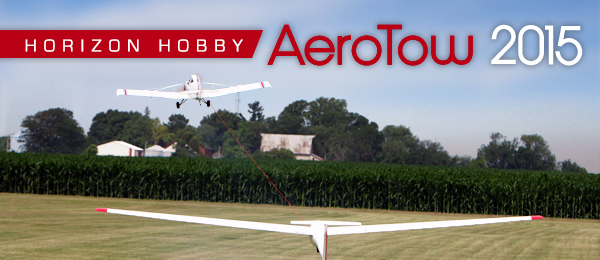
Written by Andrew Griffith Illinois might be the best place to get a tow Coverage of the 2015 Horizon Hobby AeroTow event Photos by the author As published in the February 2016 issue of Model Aviation.
Ask the average modeler, “If you could go to one of the big events that you’ve never been to but have read about in the modeling media, what event would it be?” Joe Nall Week? Top Gun? The AMA Nats? Scale Masters? Maybe the International Radio Controlled Helicopter Association (IRCHA) Jamboree? Some combination of these would probably top most people’s lists. Ask someone who owns a Scale glider though, and the answer will almost always be the Horizon Hobby AeroTow (formerly the JR AeroTow). It has been at the top of my event bucket list for a few years and things came together this year to allow me to attend. The dates were two weeks later this year so it wasn’t as close to Joe Nall Week, and Model Aviation’s Editor-in-Chief Jay Smith decided the time was ripe to feature this premier event. Horizon Hobby, with Peter Goldsmith onboard, has really done its part to promote the aerotowing segment of our hobby. With ParkZone offering products such as the UMX Carbon Cub, ASK-21, the foam K-8 glider, and Carbon-Z Cub, all the way up to the Hangar 9 33% Pawnee and the new ASW 20 Giant Scale glider, Horizon Hobby has gliders and towplanes to fit nearly any budget or size range. Marking its 13th year, the 2015 Horizon Hobby AeroTow took place June 18-21. The locale is the quaint town of Monticello, Illinois, a 20-minute drive from Champaign, Illinois, which is the location of Horizon Hobby’s corporate headquarters. Located 21/2 hours south of Chicago by car, Monticello might well be the dictionary entry for “Small Town USA.” Small shops, large houses, and long, straight roads lined with acres of corn set the stage for RC and full-scale thermal gliding. The event takes place on the outskirts of town at the Piatt County Airport, which is the home base of the full-scale Illini Glider Club. Large farm fields are crisscrossed with paved roads and barns that, when heated, combine to set off thermals. This was evident with several extremely long flights, including one by my E-flite Blanik, which was on its way to an hour when I got tired of standing in the sun and traded 1,200 feet of altitude for 2 minutes of high-energy aerobatics to get back down to land.
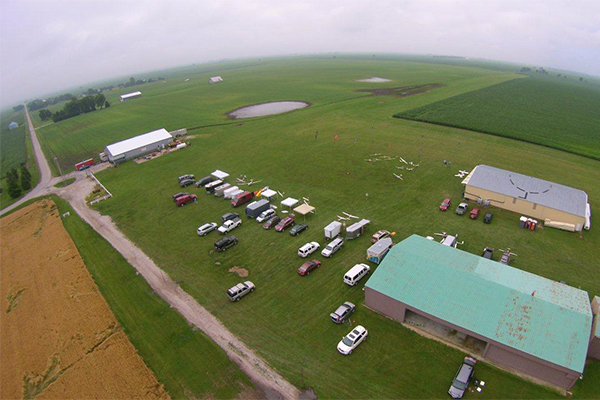
The full-scale Illini Glider Club graciously makes its hangar and runway available to the Horizon Hobby AeroTow each year.
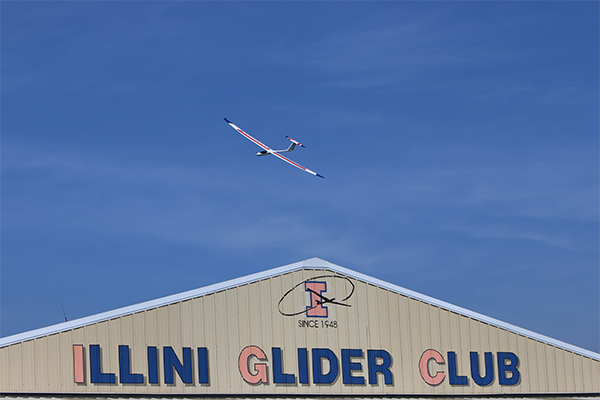
John Diniz flew this prototype electric glider before the towing got started. The long focal-length lens gives the illusion that it was right over the hangar from which we were operating.
Attendance this year was just short of 50 pilots, but many brought several airplanes and there appeared to be more than 100 gliders on site. Had it not been for a less-than-favorable weather forecast, the attendance would likely have been even higher. This was discussed with Horizon team pilot and founder of the ScaleSoaring.com forum, Len Buffinton, who said that skipping events because of weather forecasts means that it’s likely you won’t bother going to any events and will miss a great time. Despite the forecast, several good days of flying were enjoyed by those of us who chose to buck the odds and make the trip. A unique service that Horizon Hobby provides is sailplane transportation for pilots on the West Coast. You can take your airplane to the Horizon warehouse and the company will ship your glider on its warehouse truck and you can fly to the AeroTow and not have to worry about transporting a large model. When the event is over, Horizon ships it back and you pick it up at the company’s warehouse. After a long drive the day before, I headed out to the airfield first thing in the morning on Thursday to be greeted by clouds and a low ceiling. Undeterred, several fliers spent an hour or so demonstrating how Discus Launch Gliders are really flown. A couple of these pilots were throwing the airplanes higher than I often get on a hi-start launch! The weather cleared and as soon as the sound of the first gas-fired Hangar 9 Pawnee filled the air, a line quickly formed in the staging area and a long day was enjoyed until it was too dark to fly. After returning to the hotel, it was off to Champaign where a large group of attendees gathered for dinner and spent another couple of hours getting to know each other better and talking about Scale Soaring.
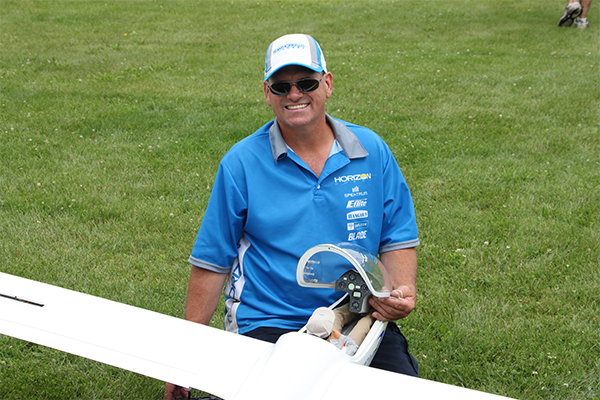
ScaleSoaring.com forum founder Len Buffinton made the trip from New England. Len always seems to have a smile on his face whether he is flying a glider, towplane, or just hanging around and socializing.
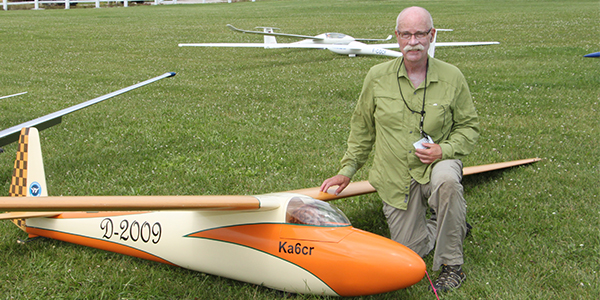
Kevin Kavaney, from Minneapolis, preps his huge KA-6CR in the staging line. Pilots needed to be ready to hook up and fly when the towplane landed to keep the line moving.
Some of the best parts of a trip are often those you don’t plan for. On Friday, the weather guessers were right and it rained most of the morning. Making the best of the situation, employees Missie Anderson and Kim Payne entertained a large group of pilots with a tour of the Horizon Hobby facilities in Champaign. I had visions of sharing pictures with our readers of the service department or the warehouse that seemed to go on forever and was stocked several stories tall. It covers several acres with hobby goodies of every shape and size. My vison was dashed when my camera was confiscated at the front desk to preserve the integrity of yet-to-be-released products. What the camera probably wouldn’t have captured was the friendly attitude of everyone I met. The entire group was made to feel at home! Back at the field after lunch, the sun made an appearance and heated things up, and the flying became even better. The front that moved through brought a wind change and instead of approaching over the short beans, landing approaches were made over the head-high corn. Without power to go around (in all but a few of the gliders), landing approaches had to be planned carefully. Most of my life has been spent as a city dweller, so I never fully appreciated the ability of corn stalks to reach up and snatch a sailplane out of midair, but apparently it can happen. Horizon Hobby pilot Dustin Buescher had to retrieve his E-flite Blanik from the corn and earned the cornfield award in the process. Another glider took nearly three hours and a camera-equipped quadcopter to locate and retrieve. After watching this action, I made sure I landed with plenty of room to spare, because after the aforementioned rain, folks returning from rescue missions were covered with mud that appeared to be the consistency of drying concrete. After another early overcast cleared out on Saturday, the line formed quickly. Late that morning, the line was such that a second towplane was pressed into service. Most of the towing was done with 100cc- and 120cc-powered 1/3-scale Piper Pawnees from Hangar 9. Peter Goldsmith had a 3W 1/3-scale Super Cub covered in a Spektrum scheme that was used to tow some of the largest gliders, but the Pawnees and the Horizon tow pilots did a spectacular job of keeping things moving smoothly. Former Tournament of Champions winner, Steve Stricker, took several long shifts towing and won the Best Tow Pilot plaque for his effort, but all of the tow pilots did a marvelous job in the often challenging conditions.
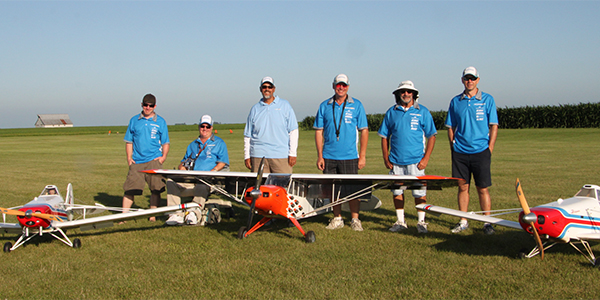
Hangar 9 Pawnees did most of the towing, with Peter Goldsmith’s 3W Super Cub doing the heavy hauling. Tow pilots included (L-R) David Payne, Steve Stricker, John Diniz, Peter Goldsmith, Rick Shelby, and Craig Greening.
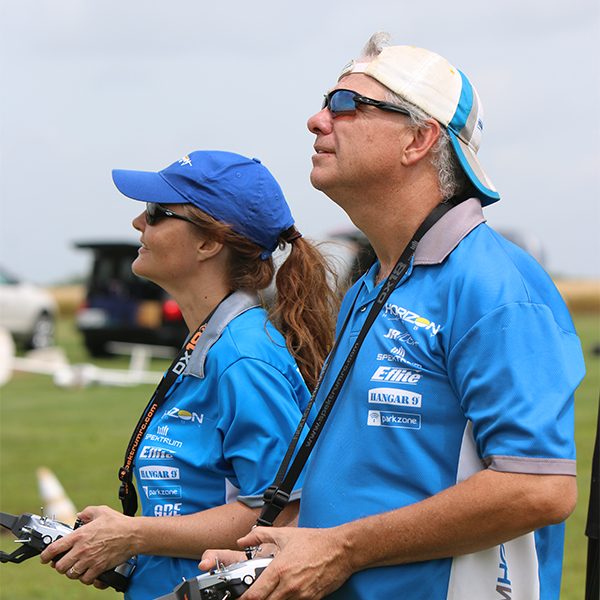
Peter Goldsmith took time out to relax and enjoy some glider flying with his wife, Caroline.
As flying wrapped up Saturday evening, the smell of barbecue wafting across the field had stomachs rumbling. After dinner, a large number of raffle prizes, including several foam models, an E-flite Allusive, and even a DX9 radio, were raffled off to a lot of smiles from the winners. Whenever I go to an event, I look for a project that stands out and this trip was no exception. There were several of the popular E-flite Blaniks at the event—at one point I counted eight within sight while waiting for a towplane. Several were repainted or decorated with different graphics, but Peter George, from St. Louis, took his a step further. In addition to a full cockpit, Peter repainted his Blanik and added custom graphics. Using sign vinyl that was a slightly different shade than the paint, Pete created squares to simulate aluminum panels, then used a fine point marker to draw panel lines and rivets over the entire airframe. The Blanik has a 4.2-meter wingspan and a bulky fuselage, so covering this entire model in rivets and panel lines is no small task. I suppose this is what you do when you can’t fly year round. Pete took home the well-deserved Blanik Achievement Award for his efforts. Bashing an ARF is one thing, but Michael Kelly, from Taylorsville, Kentucky, brought two scratch-built gliders that he can only be described as stunning. The Pilots’ Choice award went to his 1/4-scale Vampyr, based on a German glider designed in the early 1920s. Spanning slightly more than 3 meters, Michael built a version with wing warping, but to get more roll control, he converted to the 1921 version of the Vampyr that featured regular ailerons. Neither the Vampyr nor his 1/6-scale Balestruccio would look out of place on the judging table at Top Gun.
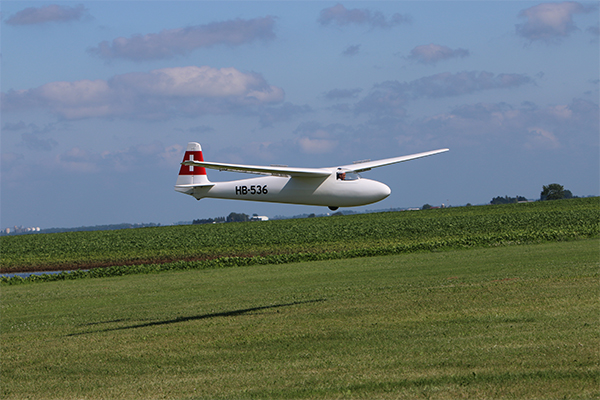
Peter George, from St. Louis, has the spoilers out as he brings in his Hempel 1/2-scale KA-6. Pete did plenty of work on this glider, making the spoilers scale accurate and adding a cockpit.
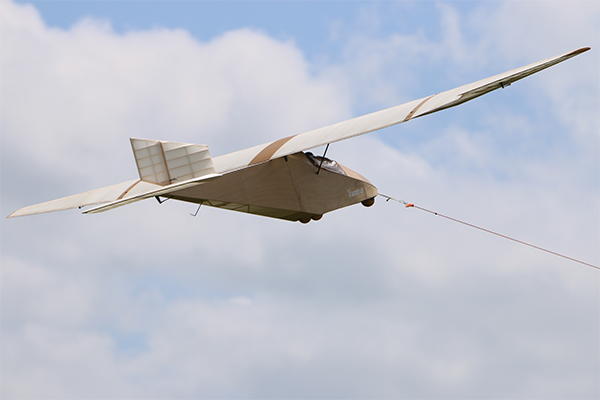
Mike Kelly, from Kentucky, held back no secrets when discussing how he scratch-built and detailed this beautiful 1/4-scale Vampyr, a 1920s German design.
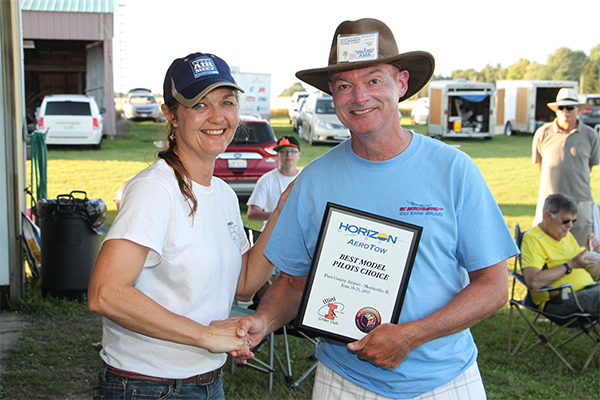
Caroline Goldsmith presents a well-deserved Best Model/Pilots’ Choice Award to Mike Kelly for his scratch-built 1/4-scale Vampyr.
With a long drive back to Florida ahead, I packed up and hit the road early Sunday morning. I had plenty of time to reflect on my experience and started putting my thoughts together for this article. I enjoyed myself immensely and the weather didn’t hamper my enthusiasm one bit—in fact, it made taking time away from the field for the tour a decision I didn’t have to make. The Horizon Hobby staff worked hard to make everyone feel not only welcome, but like family. The flying was awesome. I made more tow flights in three days than I usually do in three months, but spending three days hanging out with people whom I only get to see a few times a year was—as the commercial says—priceless. I’m sure I’ll miss a few people who deserve personal mention, but Pete Goldsmith kept the flightline moving smoothly and the tow pilots organized, and Missie and her crew kept pilot registration, the raffle, and food concessions running without a hitch. Spektrum guru Andy Kunz spent Friday afternoon at the field helping anyone with Spektrum questions or issues. Len performed maiden flights on several people’s new gliders and helped anyone who asked. If you’re interested in aerotowing, make plans to attend next year’s Horizon Hobby AeroTow. Some people shy away from events because they feel they aren’t expert pilots or for other reasons, when in fact, you won’t find more expertise, better help, or nicer people who will do anything to make sure you have a positive experience and get whatever assistance you need. Who knows, you might even make a whole new group of friends! —Andrew Griffith [email protected]










Add new comment